Villa Méditerranée looks as if it has always been part of the city of Marseille, belonging to its port and the sea. Situated at the foot of the Tourette promontory, north of the entrance to the Vieux-Port, the most significant building built to date by Boeri Studio (Stefano Boeri, Gianandrea Barreca, Giovanni La Varra) has already become an established feature of the surrounding landscape, even though it will not be quite finished until spring 2013.
The complex volume, comprising some 8,800 square metres, presents two very distinct faces, one to the city and the other to the sea. The elevation facing the high walls of Fort Saint-Jean displays a sober, contemporary, almost subdued elegance; while the facade overlooking the Mediterranean is characterised by a radically modernist design, standing out with its imposing cantilever of 36 metres, reaching for the breakwater and horizon beyond as if it were some sort of seafaring machine. This Janus Bifrons nature is achieved despite the fact that in section the building is completely wrapped by a continuous and uniform skin. Composed of large, near-white concrete panels alternating with syncopated ribbon windows of different widths and lengths, this cladding presents the obsessive leitmotifs of the firm's current output.
The mass suspended in midair is an eternal modernist dream, and here its realisation sets up an intricate, dual link with the place. Visible on the surface are striking affinities with a wide range of port structures that contrast with the horizontality of the wharves — from harbour stations to shipping control towers, with their typically functional architectural language. In this respect, it is worth remembering that Stefano Boeri is well versed in port design, an experience accumulated over a period of nearly 20 years throughout the Mediterranean: from Naples to Genoa, and from Greece to the Maddalena in Sardinia. More in depth, in Marseille the dizziness of an architecture suspended in midair inevitably recalls one of modernism's unconscious archetypes: the gigantic pont transbordeur (transporter bridge) that linked the opposite sides of the Vieux-Port, photographed by, among others, László Moholy-Nagy and mentioned on several occasions by Le Corbusier and Sigfried Giedion. Villa Méditerranée's statement seems intended to encompass not only the still visible city, but also the interrupted memory of Marseille.
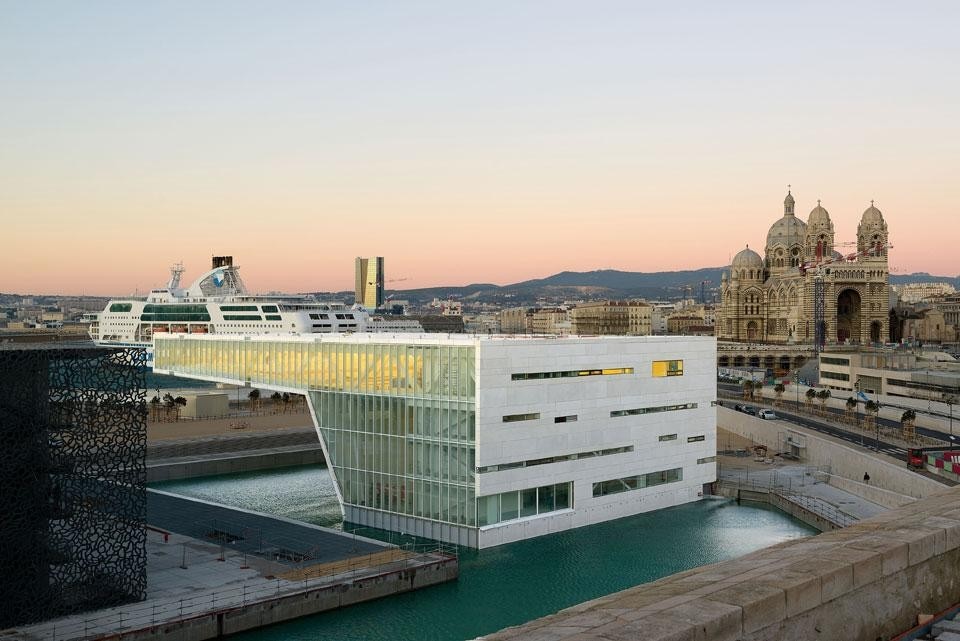
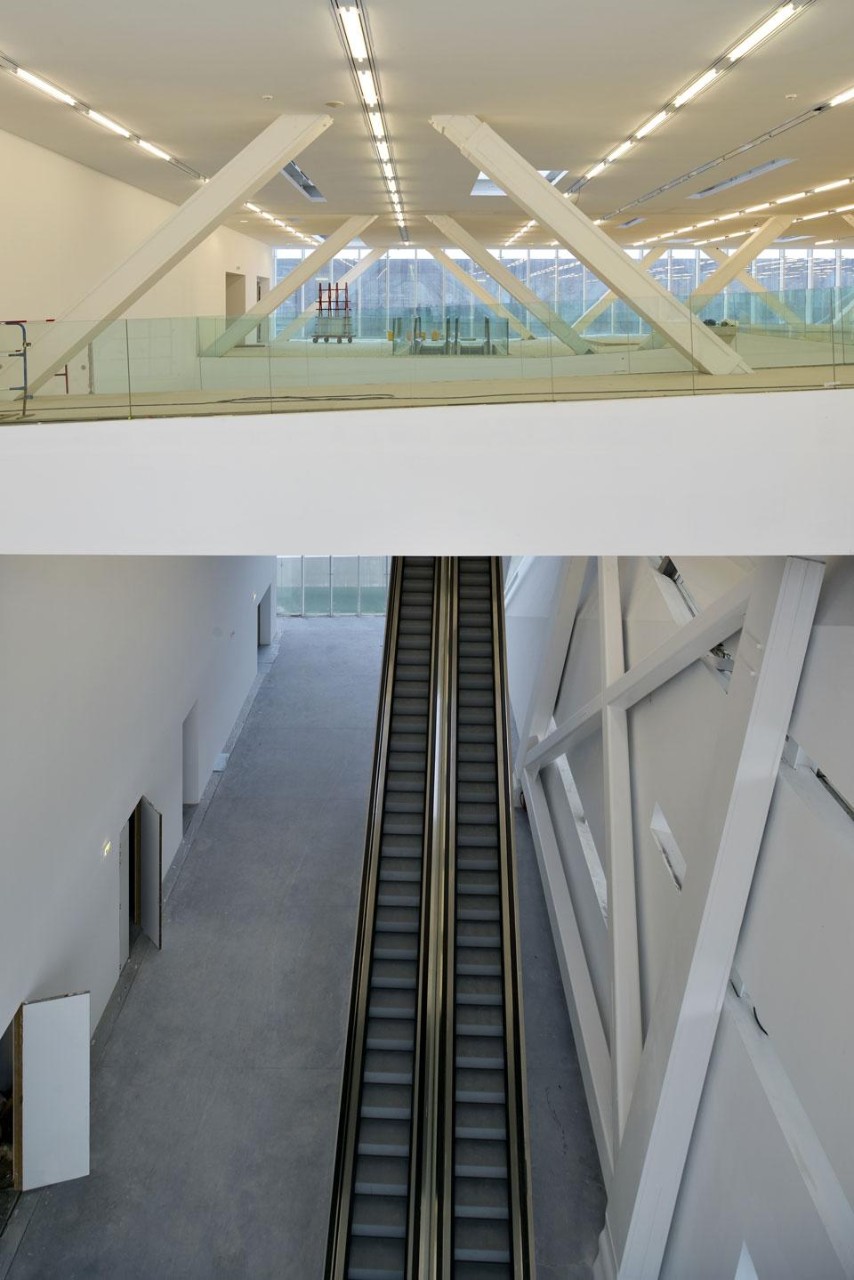
Once inside Villa Méditerranée, one encounters the built transposition of the potent, even over-explicit gesture presented in the competition project, which, however, commendably sought to outline an understandable, and in a way democratic rhetoric. The result is a truly complex and many-sided building that successfully strings together a rich and extremely diversified sequence of interiors.
The polyhedral spatial complexity of Villa Méditerranée reflects the hybrid programme that it will be hosting
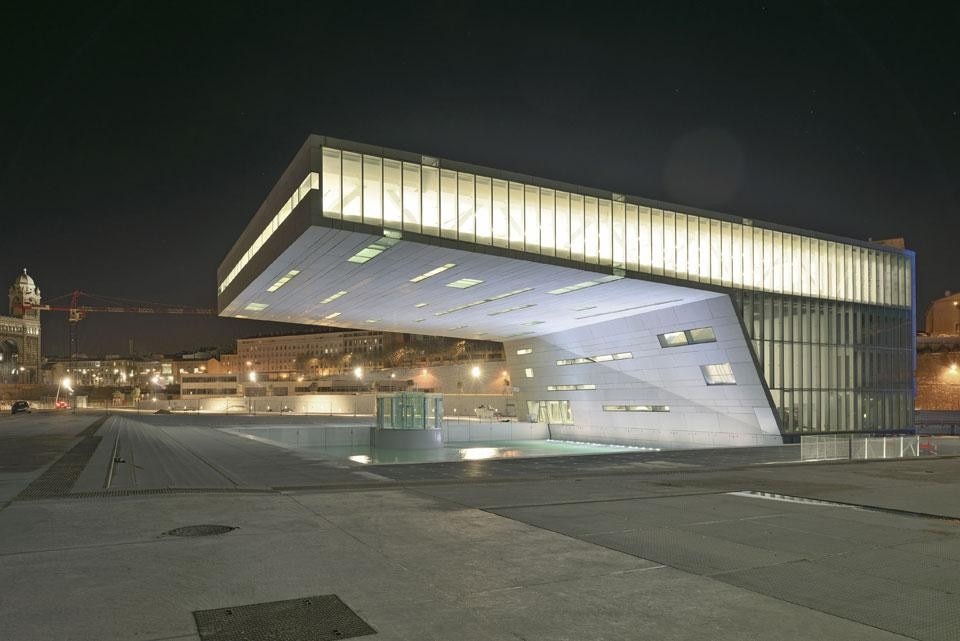
The atrium leads into the large underwater volume, diametrically opposite to the one above it, through a complex sequence of stairways. The first is straight and almost hidden by the escalator, and leads progressively towards the discovery of a second, far more spectacular staircase. With a broad, unsupported metal spiral, it provides access to the lower, public level. This wide and almost square space is dominated by the presence of four cylindrical elements: the above-mentioned staircase, the volume containing the vertical communications, a flexible space defined by a sound-absorbent mobile curtain, and the auditorium — a true wooden gem. Once again, the distinct perception of being below the surface of the sea is heightened by the tremulous light filtered through openings in the ceiling. The mute cylindrical volumes seem to be shaped by the necessity to withstand the pressure of the water. With discreet elegance, the architecture alludes to the imagery of possible underwater worlds.
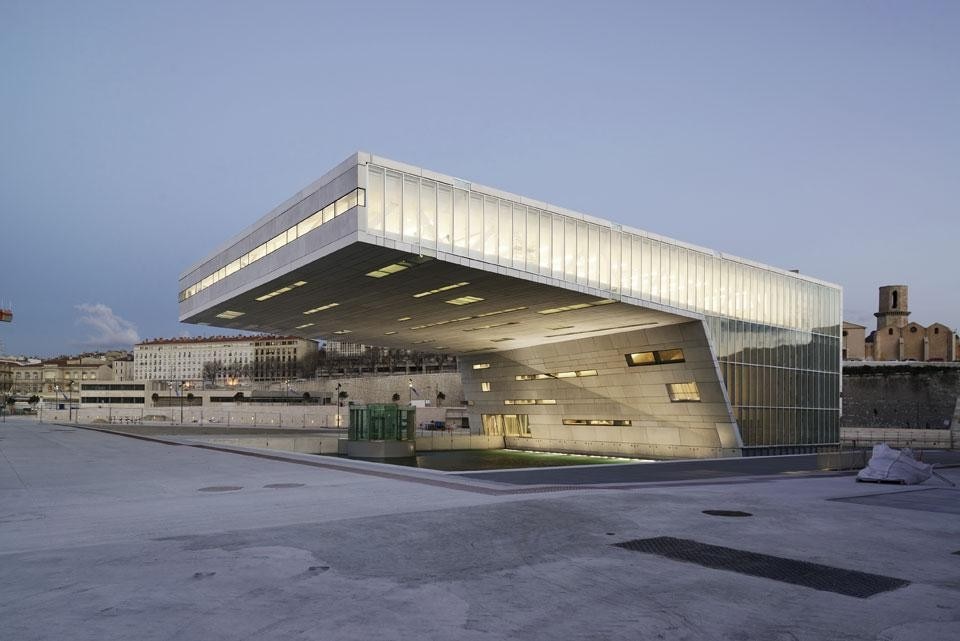
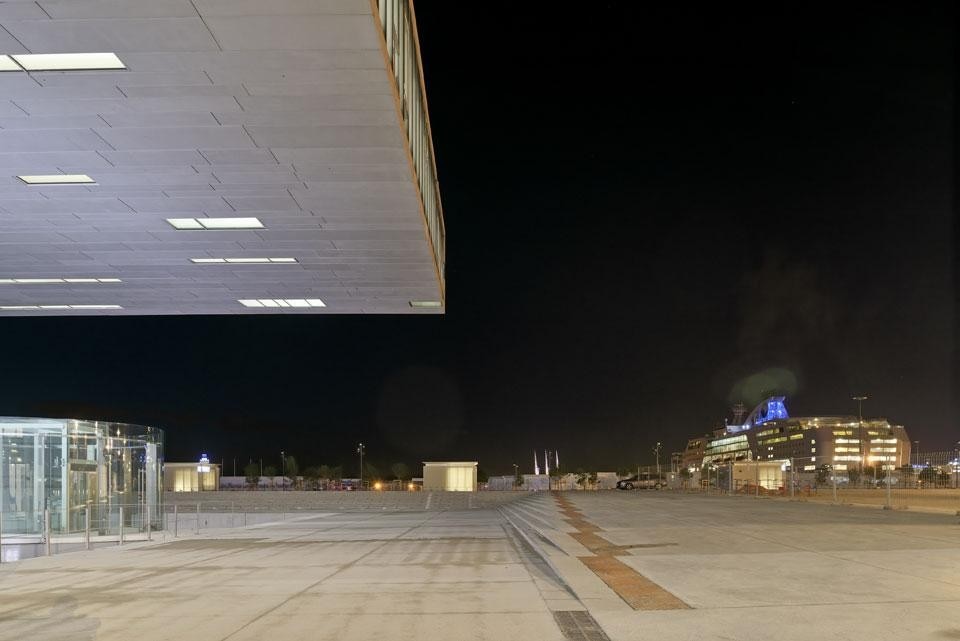
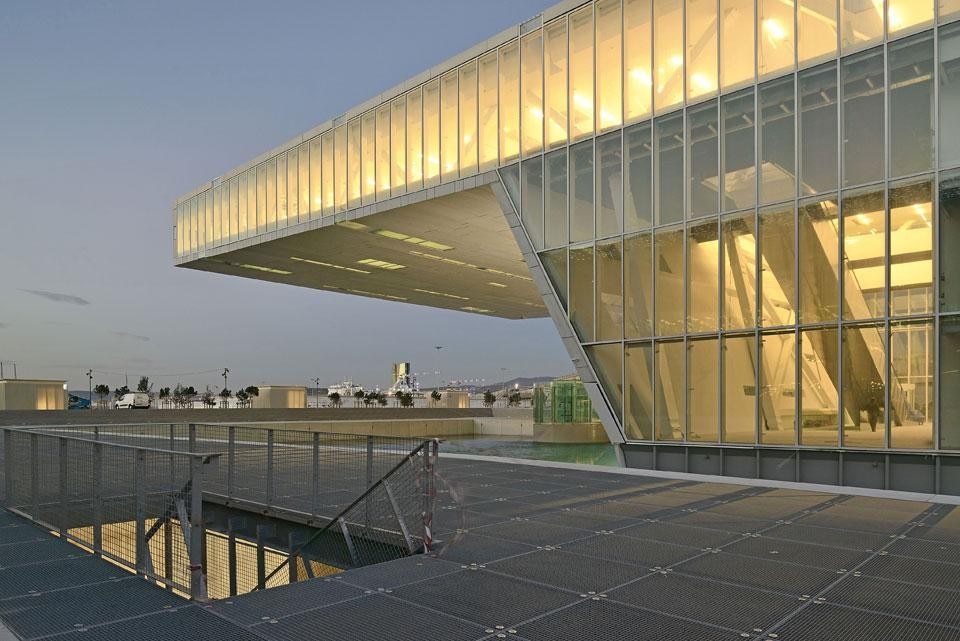
1. Villa Méditerranée is a place of thought and research that physically embraces the sea. When I designed the building in 2003, I was working with the Multiplicity group on an investigation into routes travelled by illegal immigrants in the Mediterranean. Titled Solid Sea, our study set out to highlight the new form of the Mediterranean, how it had become a "solid sea" crossed by routes that are as specialised and rigid as motorways, ones which never allow their various users (immigrants, tourists, fishermen and the military, for example) to meet or communicate. A year before, at Documenta XI in Kassel, with Multiplicity we presented the reconstruction of a tragedy that took place off the coast of Sicily: a shipwreck that claimed the lives of 283 Sri Lankan, Indian and Pakistani refugees, partly as a result of the indifference of the Italian, Maltese and Libyan authorities.
The desire to counteract this drift towards closure and isolation led to the idea of a building that, in contrast, is explicitly open to the cultural exchanges originating from the sea, welcoming researchers, students, artists, intellectuals and tourists. This structure aims to represent the extraordinary mixture of languages, tastes and colours that Marseille has received from other cities in the Mediterranean.
It is a design capable of embodying the ambitious project of Michel Vauzelle, the Provence-Alpes-Côte d'Azur region: to create a centre in Marseille for the revival of cultural and political relationships between the Mediterranean's different shores and cities, amid a Europe in crisis, a North Africa in turmoil and a Middle East being torn apart.
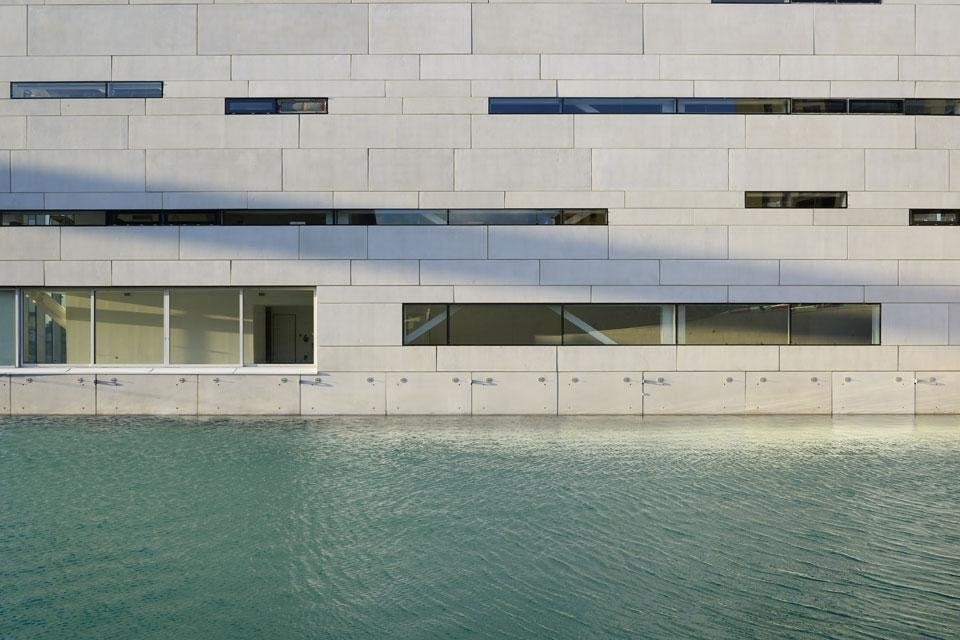
Villa Méditerranée is a construction that combines the characteristics of civic architecture with those of harbour infrastructure and off-shore platforms. Its spaces, traversed by a mixed structure of reinforced concrete and steel, are articulated in plan via three parallel, superimposed, horizontal levels, two of which are developed above and below the level of the sea — a large, 1,000-square-metre exhibition area set 14 metres above the water, and a 2,500-squaremetre space for conferences and theatrical events below. The heart of the project is the large piazza/ dock pool: a covered collective space protected from the sun and wind. The water piazza is connected to the open sea, allowing currents, fish and boats to enter the architecture. Rather than creating a pool or basin, this marine building provides useful space for mooring and sailing, for games, parties, shows, commerce and even fishing. Villa Méditerranée will be the great cavana of Marseille, a place where the city can welcome the currents of thought and life that cross the Mediterranean. Stefano Boeri, architect and professor of urban planning



